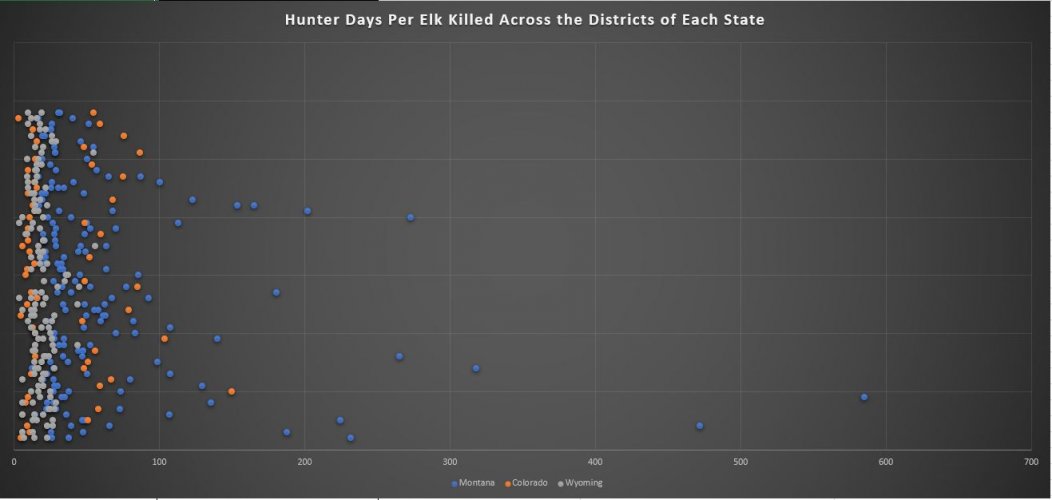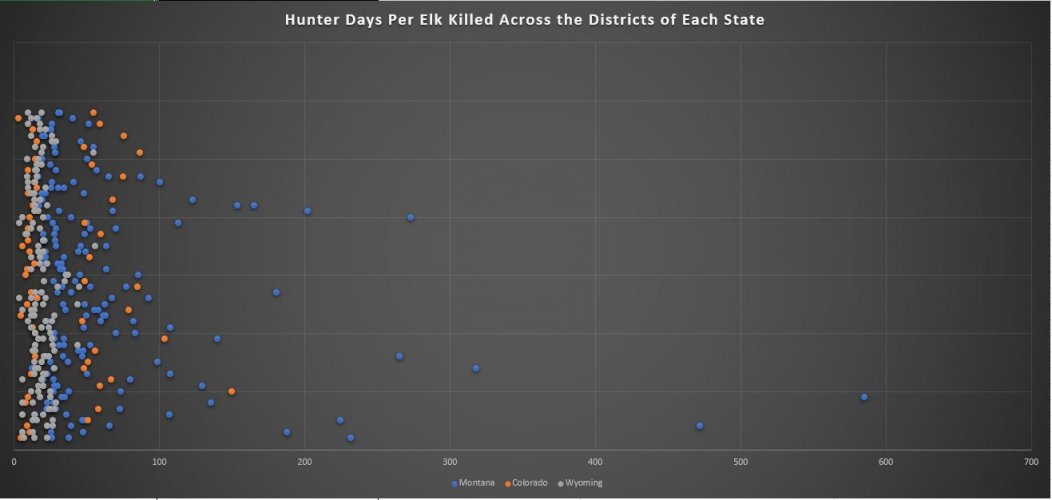Navigation
Install the app
How to install the app on iOS
Follow along with the video below to see how to install our site as a web app on your home screen.
Note: This feature may not be available in some browsers.
More options
You are using an out of date browser. It may not display this or other websites correctly.
You should upgrade or use an alternative browser.
You should upgrade or use an alternative browser.
Hunter Days Per Elk Harvested : The Metric That Matters?
- Thread starter Nameless Range
- Start date
Anyone? mtmuleyI want to know how in the Hell they come up with bull harvest down to the number of points. Not once have I ever been asked. mtmuley
T
timmy
Guest
No and I’ve tried to offer to them the districts that I’ve hunted and most years they won’t take that even. Every year I get asked if I saw a wolf though.Anyone? mtmuley
Last edited by a moderator:
shrapnel
Well-known member
- Joined
- Aug 27, 2015
- Messages
- 2,792
Numbers is numbers.
% of hunter days vs elk killed?
All numbers aside, I would guess 80% of the elk killed are killed by the same 10% of hunters, year after year.
% of hunter days vs elk killed?
All numbers aside, I would guess 80% of the elk killed are killed by the same 10% of hunters, year after year.
MTelkHuntress
Well-known member
Game check stations? But even then....now its got me wondering.Anyone? mtmuley
Lots of wolf questions though.
I have never been through a game check in decades of hunting where I do. Used to be all the quota harvest was based off of a station way South of me. A joke really. mtmuleyGame check stations? But even then....now its got me wondering.
Lots of wolf questions though.
T
timmy
Guest
Montana fwp has no handle on distribution of hunters, numbers of animals, how many bonus points it took to harvest that elkI have never been through a game check in decades of hunting where I do. Used to be all the quota harvest was based off of a station way South of me. A joke really. mtmuley
warmer
Well-known member
Not sure if I did the math correctly, but SD archery is 24 days, Black hills rifle elk was 8 and prairie elk was 10 days. Guess we are spoiled here.
Ben Long
Well-known member
I do know where 120 is. It's right out side of Kalispell. Lots of roads and lots of road hunters. Very little habitat security. Lots of whitetails and few elk, let alone brow tine bulls. I imagine this stat is skewed by "opportunistic" elk hunting. That is, people primarily after deer but with an elk tag in pocket. I do have a friend who killed a young bull in 120. Had another neighbor come with a string of mules and they packed it right to his garage door. Which was cool.I don’t know where unit 120 is, but damn! 585 days!
One of the POM metrics is that wild "survey" question... wolves.No and I’ve tried to offer to them the districts that I’ve hunted and most years they won’t take that even. Every year I get asked if I saw a wolf though.
As you say, keep hammering #mtfwp
Probably more true for guys that have good private ranches kill I bet 50% of the elk. The other 40% are killed most years by 10% hunters. The unit I hunt has a 48 day per elk harvested, which I believe is accurate. The FWP staff normally ask if I killed an elk and if a bull how many points. I have gotten 2-3 calls a years from FWP about harvest information.Numbers is numbers.
% of hunter days vs elk killed?
All numbers aside, I would guess 80% of the elk killed are killed by the same 10% of hunters, year after year.
Nameless Range
Well-known member
Here is a dot chart comparing the amount of days it takes hunters to kill an elk across the districts of Montana, Wyoming, and Colorado. Each dot represents a district and that district's hunter-days-per-elk value.
Some things I see.
-Montana has some absolutely abysmal districts.
-Montana's management seems far more volatile, with a large delta between districts
-Wyoming's management provides for quality experiences and is incredibly consistent

Some things I see.
-Montana has some absolutely abysmal districts.
-Montana's management seems far more volatile, with a large delta between districts
-Wyoming's management provides for quality experiences and is incredibly consistent

Nameless Range
Well-known member
The amount of days available (and used) for hunting increases in MT? Does it factor in the amount of days each State permits?
Basically yes. Hunter days per elk is a normalized value. One could say it isn't exactly apples to apples, but basically the metric being quantified (the amount of hunter time it takes to kill an elk in each district) is analogous across the vast majority of districts, and so this is a largely fair comparison. There may be some outliers (trophy districts, hunters who pass on legal elk, etc) but I would argue they are in the extreme minority.
I think it is pretty shocking to look at this way.

MinnesotaHunter
Well-known member
They have always asked me the number of pts.Anyone? mtmuley
kwyeewyk
Well-known member
One consideration to take is total number of hunters and days allowed to hunt. CO = lots of hunters but short seasons limits overall days available to start with. MT = relatively lots of hunters compared to Wyoming but very long seasons so lots of days available, and WY = few hunters and medium length seasons. So I think MT allows the opportunity for lots of hunter days that mathematically probably aren't possible for lots of WY or CO, even considering the low elk density units. If a resident that lives in a low density Mt HD drives around with their bow and rifle all season and never find one by the road but report that they hunted from September through November it will drive those days up.Basically yes. Hunter days per elk is a normalized value. One could say it isn't exactly apples to apples, but basically the metric being quantified (the amount of hunter time it takes to kill an elk in each district) is analogous across the vast majority of districts, and so this is a largely fair comparison. There may be some outliers (trophy districts, hunters who pass on legal elk, etc) but I would argue they are in the extreme minority.
I think it is pretty shocking to look at this way.
View attachment 195221
I suspect adding more days to the seasons in WY and CO would result in higher days per harvest, assuming the success rate increase wouldn't be linear. Some people will never kill one consistently no matter how many days you give them, whereas those who consistently kill will still be mostly successful if you give them less days.
There's probably a way to normalize the length of season for comparison but I haven't done stats enough recently to say how.
I still think it's a very interesting graph that tells the overall story though, thanks for putting it together.
Not me. Not once. mtmuleyThey have always asked me the number of pts.
Nameless Range
Well-known member
Good comment. I don't really know how one would do that, but I think you are right that Montana's longer seasons lends itself to "extending" the data. That said, I don't think it extends it so much that the story would change a whole lot. Montana puts the average days per hunter out there, and for nearly every district it is in the 6-9 days per season range. It would be interesting to see that same stat for Wyoming and Colorado, but I haven't dug for it.One consideration to take is total number of hunters and days allowed to hunt. CO = lots of hunters but short seasons limits overall days available to start with. MT = relatively lots of hunters compared to Wyoming but very long seasons so lots of days available, and WY = few hunters and medium length seasons. So I think MT allows the opportunity for lots of hunter days that mathematically probably aren't possible for lots of WY or CO, even considering the low elk density units. If a resident that lives in a low density Mt HD drives around with their bow and rifle all season and never find one by the road but report that they hunted from September through November it will drive those days up.
I suspect adding more days to the seasons in WY and CO would result in higher days per harvest, assuming the success rate increase wouldn't be linear. Some people will never kill one consistently no matter how many days you give them, whereas those who consistently kill will still be mostly successful if you give them less days.
There's probably a way to normalize the length of season for comparison but I haven't done stats enough recently to say how.
I still think it's a very interesting graph that tells the overall story though, thanks for putting it together.
Last edited:
LopeHunter
Well-known member
Hunt days per hunter that harvested an animal.
Hunt days per hunter that did not harvest an animal.
Break both of those out by Resident and Non-Resident.
Average age of harvested animal.
Those would help me figure out where to head along with private vs public land % which I can see now. Once in a while the public land ratio looks good then figure out the majority of animals start then stay on private or soon end up on private. I recall researching an antelope unit in WY with decent harvest rates and relatively easy to draw without using points that looked decent for the amount of public lands then turns out the land the antelope prefer was mostly private or landlocked public. The accessible public land was not very attractive to antelope.
Hunt days per hunter that did not harvest an animal.
Break both of those out by Resident and Non-Resident.
Average age of harvested animal.
Those would help me figure out where to head along with private vs public land % which I can see now. Once in a while the public land ratio looks good then figure out the majority of animals start then stay on private or soon end up on private. I recall researching an antelope unit in WY with decent harvest rates and relatively easy to draw without using points that looked decent for the amount of public lands then turns out the land the antelope prefer was mostly private or landlocked public. The accessible public land was not very attractive to antelope.
Similar threads
- Replies
- 6
- Views
- 2K
- Replies
- 20
- Views
- 479
- Replies
- 1
- Views
- 309
- Replies
- 30
- Views
- 3K




